Counter-Memories
On Seeds and Memories
The intervention carried out in São Paulo, starring the Guarani people of the Barragem and Kalipety villages, in association with the Terreyro Coreográfico group—formed by artists coming from various areas—, evokes counternarratives that question the official history.
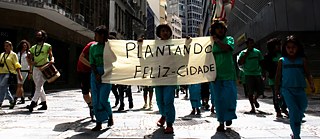
“A corn stalk is going to sprout! An orange tree is going to sprout!” “What does this ritual mean? Abundance?” “Thank you, people!” These were the comments I got to hear from the people that live in Praça da Sé (Sé Square) and in the streets that surround it as they watched the Guarani people planting their corn seeds in the beds of the square located to the side of the statue in memory of Father Anchieta.
The intervention, performed on the afternoon of November 26, featured some of the Guaraní people of the Barragem and Kalipety villages in association with the Terreyro Coreográfico group, which comprises artists of various areas. The action, which is part of the “Counter-Memories” project, conducted by the Goethe-Institut, featured Benjamin Seroussi and Clara Ianni’s curatorship, and its goal was to evoke narratives that question the official history from public spaces and elements of everyday life.
From the path I accompanied, from what I was able to see and the conversations that I had, I will try to weave some reflections on what is the meaning of the spaces traveled for the different people that participated in the action, in order to understand what are the narratives evoked by this performance. First of all, it should be stressed that the groups that staged the action on November 26, the Guarani people and the artists, already had some common history. Members of Terreyro Coreográfico had already visited the Barragem and Kalipety villages and even performed part of a play of theirs over there. And recently, in the context of the same project, before the Guarani people came to the city, the artists had visited the Kalipety village, where they held a collective planting along with members of the community on October 22.
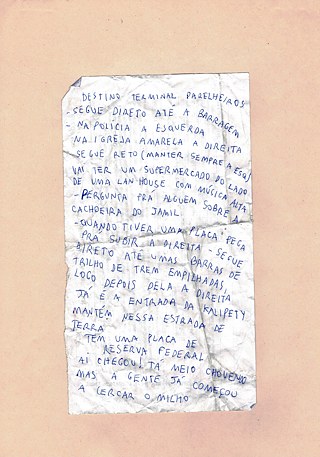
I quickly remembered another action done in April 2014 when, after Indian Day, the Guarani people of São Paulo occupied the interior of Pátio do Colégio, slept there, and the next day, they held debates and rituals demanding the demarcation of their land. On a video made by the Guarani Yvyrupa Commission, it was reported that April 19 was a complete deception, that there was nothing to celebrate and that the true Indian Day would be when the right to their lands was recognized. They pointed out, then, that they did not want back the place that white people had stolen from them long ago, but instead for them to recognize their territories located at the margins of the city, where there were still crops left, so that they could live in line with their way of being.
During that demonstration, the square was completely occupied by indigenous people, their supporters, the media, and curious passers-by. The claim for the demarcation of the land was clear. Much had changed this second time. Tiago Karai, leader of the Kalipety village, summed up the importance of the November 26 action: “People occupied the city to show that the city occupied the people.” However, he himself told me, at some point, that he no longer has the energy to participate in the demonstrations in the city such as those from 2013 and 2014, when the first acts for demarcation were done, when it was still something new and they had the strong feeling that they would achieve (as they did!) the demarcation of their land. In 2015, the Ministry of Justice signed the Declaration of the Jaraguá Indigenous Land. The same happened with the Tenonde Porã Indigenous Land in 2016. Despite that, such processes have not yet concluded and are threatened by various setbacks that have occurred with regard to indigenous policy.
I was marked by a certain feeling of discouragement and fatigue among some Guarani people on November 26. In fact, many of them confessed that they’d rather be in the village at that time. Laudiceia, who also participated in the 2014 rally, told me he’d rather be playing soccer that day, and that they, the people from the Kalipety village, usually played all day Sunday with the people from the Tape Mirim village, which is located nearby.
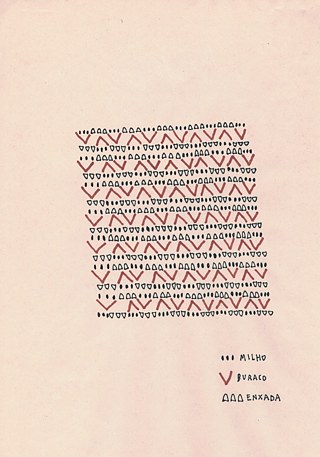
I quickly remembered another action done in April 2014 when, after Indian Day, the Guarani people of São Paulo occupied the interior of Pátio do Colégio, slept there, and the next day, they held debates and rituals demanding the demarcation of their land. On a video made by the Guarani Yvyrupa Commission, it was reported that April 19 was a complete deception, that there was nothing to celebrate and that the true Indian Day would be when the right to their lands was recognized. They pointed out, then, that they did not want back the place that white people had stolen from them long ago, but instead for them to recognize their territories located at the margins of the city, where there were still crops left, so that they could live in line with their way of being.
During that demonstration, the square was completely occupied by indigenous people, their supporters, the media, and curious passers-by. The claim for the demarcation of the land was clear. Much had changed this second time. Tiago Karai, leader of the Kalipety village, summed up the importance of the November 26 action: “People occupied the city to show that the city occupied the people.” However, he himself told me, at some point, that he no longer has the energy to participate in the demonstrations in the city such as those from 2013 and 2014, when the first acts for demarcation were done, when it was still something new and they had the strong feeling that they would achieve (as they did!) the demarcation of their land. In 2015, the Ministry of Justice signed the Declaration of the Jaraguá Indigenous Land. The same happened with the Tenonde Porã Indigenous Land in 2016. Despite that, such processes have not yet concluded and are threatened by various setbacks that have occurred with regard to indigenous policy.
I was marked by a certain feeling of discouragement and fatigue among some Guarani people on November 26. In fact, many of them confessed that they’d rather be in the village at that time. Laudiceia, who also participated in the 2014 rally, told me he’d rather be playing soccer that day, and that they, the people from the Kalipety village, usually played all day Sunday with the people from the Tape Mirim village, which is located nearby.
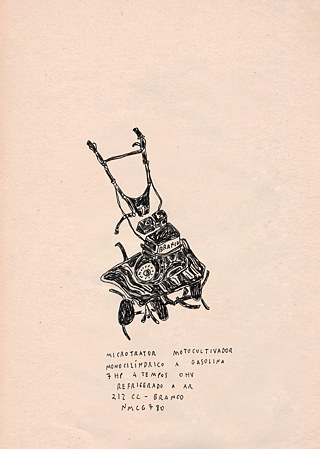
Praça da Sé and its surroundings are in fact really curious places for anyone who aims to discuss memory and historical narratives in our city. If its monuments tell the so-called glorious story of the foundation of São Paulo, the current state of the region seems to make this narrative embarrassingly ironic. Inhabited by hungry homeless people, constantly abused by the police, located next to a law school where the children of the country’s economic elite study, and considered by many Paulistanos as “an area barely visited” and “dangerous to walk in at night,” Praça da Sé explicitly displays the city that did not go well. Everyone there, both the homeless people that joined our group in the expectation that the seeds would bear fruit, and the men who listened to the pastor’s sermon, seemed to be awaiting a miracle.
These places marking the foundation of São Paulo represent the beginning of a long process of violence suffered by indigenous people. A significant indicator of this is the astounding number of nearly 200,000 Guarani indigenous people who, captured by the Bandeirantes [explorers and fortune hunters of Portuguese origin in Brazil during the 17th century], served as slave labor for the construction of the city between the 16th and 17th centuries, as reported by John Manuel Monteiro in Negros da terra: índios e bandeirantes nas origens de São Paulo [Black People from the Land: Indigenous People and Bandeirantes in the Origins of São Paulo].
Driven from their land, watching as their crops were destroyed, the Guarani people were reduced to small areas where there was no possibility of grow their food and gather their medicines; they began to rely increasingly on the property and money of the non-indigenous people. As we were walking across the square, Aline and Priscilla told me that this place brought them childhood memories, when they used to come with their parents to borrow money from the white people that walked by.
Today the two women live in the Kalipety village, although before that they had to stay for a long time in the Barragem village, an area of only 26 hectares with a population of more than 600 people, where there was no space to grow what they needed: they no longer had medicinal plants or places to hunt. However, the reconquest of the Kalipety village seems to signify for them a change in the narrative on the loss of the land and the culture so lamented by the Guarani. Despite having met some initial threats and a land that was too dry due to the monoculture of eucalyptus, the new village had the space and the silence that they craved. The Guarani people quickly recovered the soil of the new village with their agro-forests and managed to reproduce a wide range of varieties of corn and sweet potato.
It was that village that the members of Terreyro Coreográfico visited on October 22, when they decided to support the Guarani people in organizing a collective mobilization for planting. In a story told that day, Tiago Karai mentioned that his people are farmers, that they live together with their seeds. To him, the seeds are a way of carrying the memory of their ancestors, to pass them on from generation to generation. Thus, expelled from their land, the Guarani people took their seeds wherever they went with the hope of one day being able to plant them and see them grow, remembering their ancestors and reversing the official history that has sought to erase them.
Daniel told me that he didn’t believe a space could really be rethought only by holding an isolated event in it. To him, it is necessary opt for the insistence of the gesture, like in a choreography, as it is through its repetition that it will gain meaning and intensity. Marquinhos, a young Guarani who was cheerful during the action, told me that he believed that the corn would grow in the square and that the inhabitants would take care of their seeds. He will come back in a few weeks to see if the corn stalks have grown. I hope he’s right!
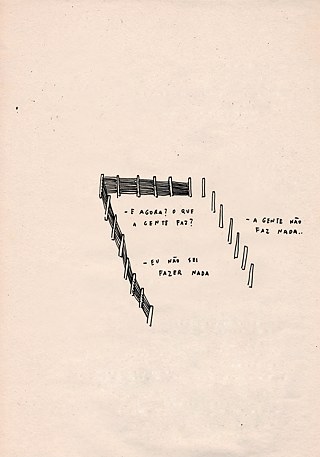
We rested a bit, then, while the demonstration was turning around the block. After a while, the Guarani people were called to join the act again and get into the car with music to sing and to strengthen the fight. I initially thought it was an awkward moment. It seemed to me that the Guarani people had no desire to participate in the demonstration. Still, Daniel told me later that he saw young people from the Barragem village who were really happy to sing for the crowd that listened to them intently.
My sister, who is also an actress, and whom I met by chance in the demonstration, told me she had been very happy about the participation of the Guarani people, as their presence gave the demonstration another sense of what the fight for the land was, now that it was also being done by the inhabitants of Bixiga. She told me that José Celso Martinez Corrêa understands the space of the Workshop as a single field, as a sacred land in which, after the installation at the theater, the plants began to sprout in the middle of the city, watered by the river, still unchanneled, still running live underneath the earth; and that the process of gentrification suffered by the inhabitants and artists of Bixiga brings to light the issue of the struggle for the land against a capitalism that insists on expelling people from the places where they live, plant, and create bonds.
Celebrated by the crowd as they got into the car with music, the Guarani people sang again, among other tunes, the one I mentioned earlier, where they talk about all the nice things that were left by the divinities and destroyed by white people. In the end, they asked the young man who was playing the guitar and leading the choir what his music meant. And he answered: “The music speaks about our struggle, about our culture.” Daniel added: “People planted corn in Praça da Sé. Water it when you pass by. That is also reconquering.”
*Visual artist Guga Szabzon made the illustrations that accompany this text, inspired by the community planting of corn in the Kalipety village, last October 22.